In the first unit “Amos 01 – Observation” we have started to see many things in the text. In order to understand and interpret the prophecy of Amos better, we have to look at the background: Who was Amos? What do we know about his life? To whom does he speak? What is the situation of Israel at that time? What issues does he address? What prediction does he make? How are do these predictions fulfill in history?
Interpretation Question 01: Who wrote this prophecy? What do we know about his life?
Instruction
Find any verses in Amos that speak about the author, any self-description or any event in the text about him and collect the information you find.
Example
Amos 1:1 “The words of Amos, who was among the shepherds of Tekoa …”.
- The author is Amos. He is a shepherd. He is from a place called Tekoa. He gives no father’s name, nor does he give himself any other title or description (like ‘prophet’ or ‘priest’ or anything like that).
Findings
Amos 1:1 “The words of Amos, who was among the shepherds of Tekoa …”.
- The author is Amos.
- He is a shepherd. He is from a place called Tekoa. Some background information: Tekoa was a small fortified city about 16 km south of Jerusalem, located in a high hilly area with Tekoa being in the rain shadow of the main North-South ridge. Tekoa is therefore rather dry and not very ideal for shepherds.
- Amos gives no father’s name, nor does he give himself any other title or description (like ‘prophet’ or ‘priest’ or anything like that).
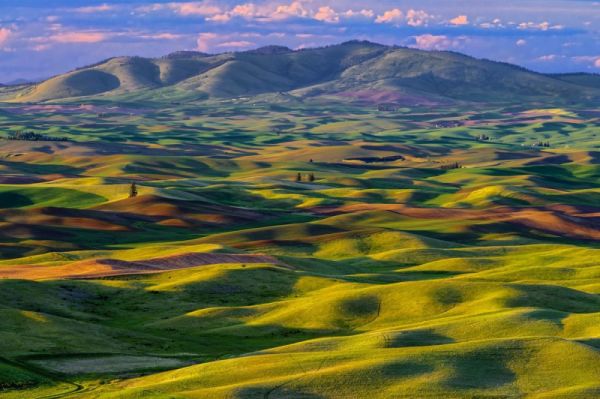
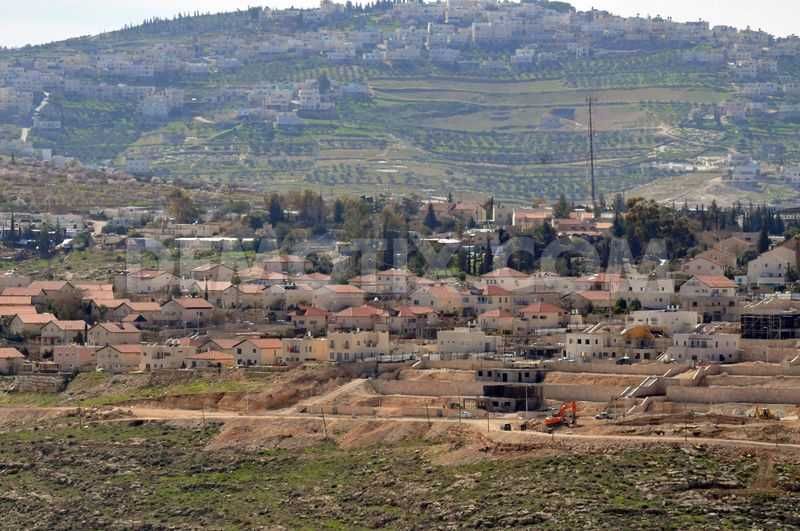
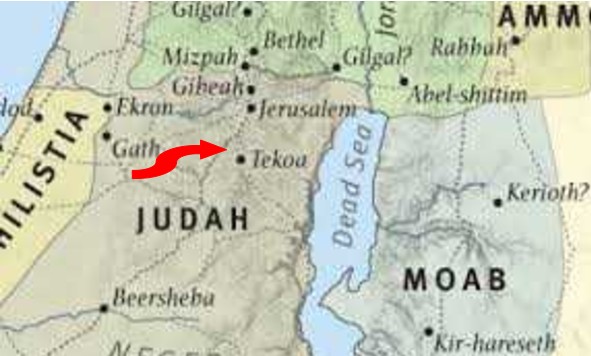


Amos 7:14 “I am no prophet nor a prophet’s son, but I am a herdsman, and a dresser of sycamore trees, and the LORD took me from following the flock, and the LORD said to me, ‘Go, prophesy to my people Israel’”
- Amos when challenged asserts a clear call from God, but doesn’t put himself in the line with ‘prophets in general’. He rather stresses his normal life as a laborer: He is a herdsman and a dresser of Sycamore trees.
- The reference to sycamore trees gives further insights. Some background information: Sycamore fig trees (“Ficus sycamorus”) only grew in the lower hills of Judah towards the West, near the Philistia. Sycamores produce fruit, but sycamore fruit was not a marketable item, rather a fruit that mainly the poor ate. Since Sycamores do not grow where Amos lives, we can deduce that Amos was a seasonal worker, who migrated to the lower hills for work there, but his main job was shepherding in Tekoa. It seems that Amos knows the problems of poor workers very well, as is also reflected in his prophecy.
Amos 7:12 When Amaziah, the priest of Bethel patronizingly tells him to “flee away to the land of Judah” and to “earn your bread, and prophesy there”, Amos indignantly disassociates himself from prophesying for money, from being that sort of a “seer”.
- Amos when challenged by Amaziah also asserts a clear call from God, but doesn’t put himself in the line with ‘prophets in general’. He rather stresses his normal life as a laborer: He is a herdsman and a dresser of Sycamore trees.
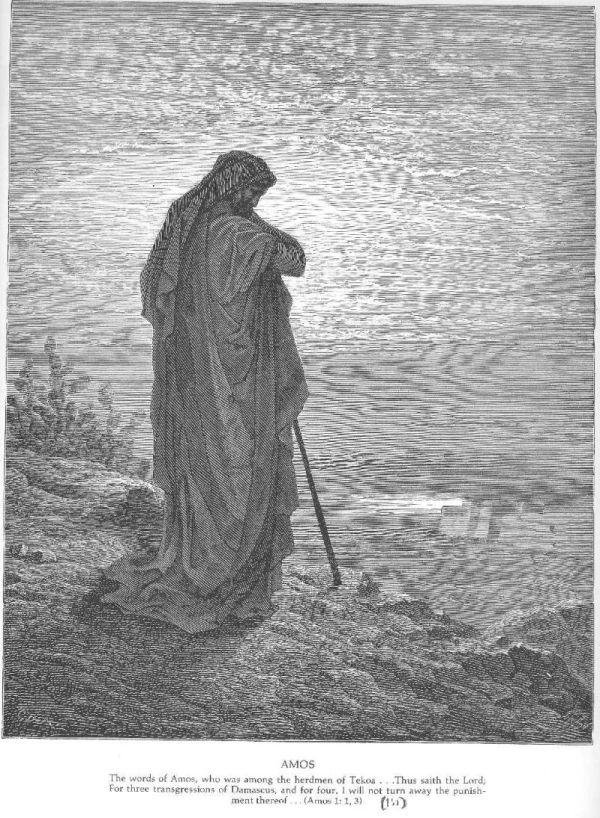
Amos 3:8 A longer sequence of questions culminates in this statement of Amos’: “The lion has roared; who will not fear? The LORD God has spoken; who can but prophesy?”
- Amos here says that one cannot but prophesy, that his prophesying is not a prestigious pursuit, rather a bare necessity in the face of God and the situation in Israel.
Amos 4:6-13 These verses describe a series of 5 partial judgments of God, by which God is trying to get Israel’s attention, though unsuccessfully. Amo 4:6 … famine, lack of bread … yet you did not return to me … Amo 4:7-8 and I also withheld the rain from you … yet you did not return from me … Amo 4:9 blight, mildew, locusts … Amo 4:10 pestilence … Amo 4:11 military set-backs … “yet you did not return to me.”
- This is written in past tense, so it seems Amos, even though only a shepherd sitting in Judah, is watching and discerning what is happening in Israel. He sees it boom under Jeroboam II (2 Kin 14:23-27).
- He also seems to realize that the appearance is better than the reality. He interprets the partial judgments as God trying to shake up Israel (as per Lev 26 and Deu 28), but unsuccessfully. When was this? Historical information: Assyrian inscriptions mention a plague ravaging the Near East in 765 BC.
- This seems to have been captured to perfection in Gustave Dore’s famous masterpiece engraving called “Amos”, see the picture.
- Amos’ character displays availability, obedience, courage, a disregard for opposition and a deep fear of God.
Interpretation Question 02 a: To whom does Amos speak?
Instruction
Find any verses in Amos that speak about Amos’ addressees, those who hear his prophecy.
Findings
Amos 1:1 “The words of Amos, who was among the shepherds of Tekoa, which he saw concerning Israel …”.
- Amos declares his prophecy to be about Israel, meaning the Northern nation of Israel, comprised of ten tribes of Israel.
- Amos himself is from the Southern nation of Judah, comprised of roughly two tribes of Israel (Judah, Simeon).
- Recall the history of the division of Israel into two nations just after the death of King Solomon in 931 BC. For details read 1 Kin 11-12.
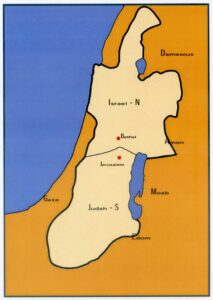
Amos 7:10-17 Amos addressing Israel at Bethel.
- These verses show that Amos actually travelled to Bethel, the spiritual center of Israel (see map) and spoke his prophesy there. Amaziah, the priest of Bethel informs king Jeroboam II of Israel about Amos’ destruction prophecy and at the same time in a rather patronizing and belittling way tells Amos to disappear.
- We learn from this that Amos addressed Israel at Bethel, likely during one of the yearly feasts in Bethel, when people from all over Israel would be present.
Interpretation Question 02 b: To whom does Amos write?
Findings
- We know from history that within about 30 years of Amos’ prophecy, the nation of Israel is conquered and destroyed by the Assyrians in 722 BC and its surviving population exiled to various places in the Assyrian empire (2 Kin 17).
- These Israelites, who already had been idolatrous for nearly two centuries, dissolve into the surrounding idolatrous peoples and there never is a return or a re-assertion of their identity or their call. They are lost to history.
- But who then preserves Amos’ prophecy? The answer by implication is Amos’s native country of Judah.
- It seems that Israel didn’t respond to Amos’s message, but with Israel’s destruction in 722 BC Amos is declared a prophet of God by virtue of his prophecies fulfilling (Deu 18:22) and probably those who feared God in Judah would have listened up and valued his prophecy.
- It thus seems that Amos spoke to Israel but wrote mostly to Judah. See picture.
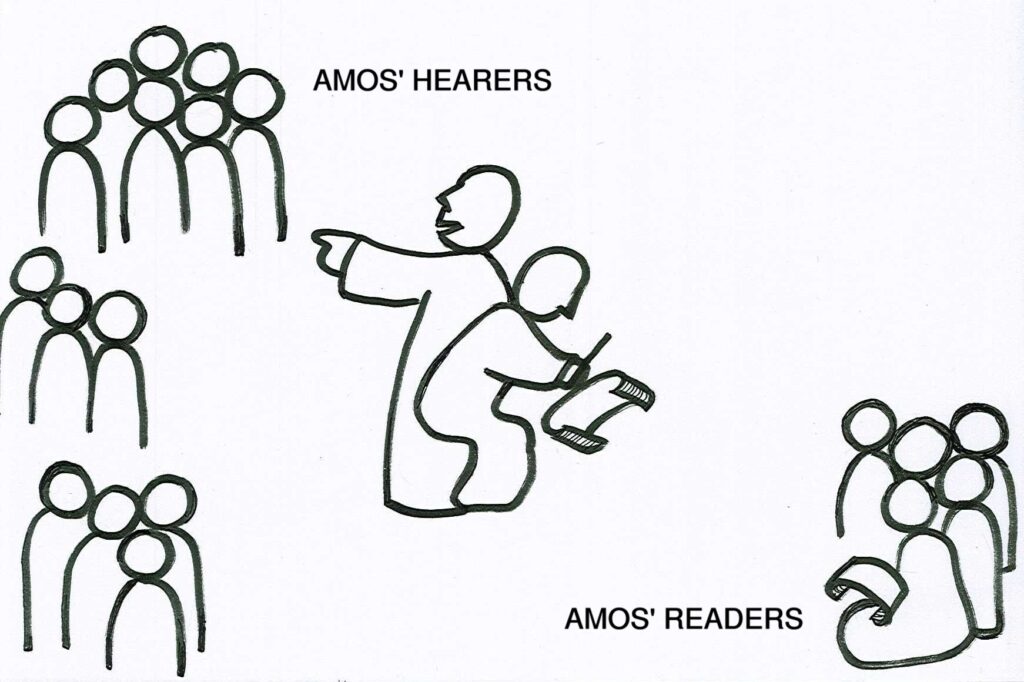
Interpretation Question 03: When did Amos speak his message?
Instruction
Find any verses in Amos that help us put a date or historical link to Amos’ message.
Amos 1:1 “The words of Amos, who was among the shepherds of Tekoa … in the days of King Uzziah of Judah and in the days of King Jeroboam of Israel, two years before the earth quake.”
Amos 7:10 “Then Amaziah, the prist of Bethel, sent word to King Jeroboam of Israel, saying “Amos has conspired against you at the very center of the house of Israel”
- Amos clearly dates his prophecy, linking it to Jeroboam II, king of Israel and Uzziah, king of Judah:
- Jeroboam co-reign with father 793-782 BC single reign 782-753 BC
- Uzziah co-reign with father 790-767 BC single reign 767-750 BC reign with son 750-739 BC
- The time of overlap is 790-753 BC.
- Amos 4:10 mentions a plague ‘(“pestilence after the manner of Egypt”) in past tense. This most likely refers to a plague recorded by the Assyrians in 765 BC.
- Amos 1:1 mentions “two years before the earthquake”. This earthquake was so strong that the prophet Zechariah refers to it 250 years later in Zec 14:5 “you shall flee as you fled from the earthquake in the days of King Uzziah of Judah.” This earthquake is also mentioned by Jewish historian Josephus Flavius in his “Antiquities of the Jews”, Book IX, Ch.10, who writes later, but uses earlier records. No exact date is known for it.
- Amos possibly refers to a coming earthquake in Amos 8:8 “Shall not the land tremble on this account, and everyone mourn who lives in it” in Amos 9:5 ”He who touches the earth and it melts, and all who live in it mourn.”
- Maybe the earthquake 2 years after the prophecy confirmed Amos as a prophet of God and made people take his message more serious. Maybe it also lead to a demand for having his words in written form. Maybe Amos chose to record the earthquake to give authority to his writing.
- In summary we can say that Amos spoke within 790-753 BC. Usually the date is put at 760 BC.
04 Interpretation Question: What was the political situation when Amos prophesied?
Instruction
Thanks to Amos’ dating of his prophecy, we can reconstruct the historical background for this book. Read 2 Kin 14:23-27, which describes the reign of Jeroboam II and think carefully about the information given.
Find Jeroboam on the list of Kings of Israel on the right and notice the 9 dynasties that rule Israel in its 207 year history.
Findings
In order to understand Jeroboam II better, we need to look at the history of his family. Jeroboam II is part of the longest lasting dynasty that ruled Israel. Usually a new king coming to power established a new dynasty, but already in the time of his son things fall apart. Jeroboam’s family lasted 5 generations, a record among the unstable political leadership of Israel.
It is also interesting that the only king of Israel who is not called “evil” in the book of Kings is Jehu, the founder of the dynasty Jeroboam II is a part of. Following is a short summary of Jehu’s dynasty:

King Jehu 841-814 BC partially obedient promise of 4 generations
- In 841 BC Jehu is anointed king over Israel by an emissary of prophet Elisha (2 Kin 9).
- He is tasked to wipe out Ahab and his family, to kill Jezebel and to kill off the priests and the worship of Baal in Israel.
- He obediently does that, though he does not do away with the calves at Bethel and Dan.
- For this he is promised in 2 Kin 10:30 “Because you have done well in carrying out what I consider right, and in accordance with all that was in my heart have dealt with the house of Ahab, your sons of the fourth generation shall sit on the throne of Israel.”
- So Jehu is promised 4 generations on the throne, a prophecy fulfilled with his son Jehoahaz, Joash, Jeroboam II and Zechariah. The relative longevity of Jehu’s dynasty is squarely due to the relative obedience of its founder Jehu.
King Jehoahaz 814-798 BC evil 1st generation from Jehu
- 2 Kin 13:1-6 says about Jehoahaz: “Jehoahaz son of Jehu began to reign over Israel in Samaria; he reigned seventeen years. He did what was evil in the sight of the LORD … The anger of the LORD was kindled against Israel, so that he gave them repeatedly into the hand of King Hazael of Aram, then into the hand of Ben-hadad son of Hazael. But Jehoahaz entreated the LORD, and the LORD heeded him; for he saw the oppression of Israel, how the king of Aram oppressed them. Therefore the LORD gave Israel a savior, so that they escaped from the hand of the Arameans; and the people lived in their homes as formerly.”
- Around 815 BC Syria grows strong and oppressive under King Hazael. The “savior” promised probably refers to King Adad-Nirari of Assyria who defeats Syria during the reign of Ben-Hadad II, son of Hazael.
- Assyria becomes the strongest power of the day, Syria is weakened and Syria’s grip on Israel loosens.
King Joash 798-782 BC evil 2nd generation from Jehu
King Jeroboam II 782-753 BC evil 3rd generation from Jehu
- 2 Kin 14:23-29 says “King Jeroboam son of Joash of Israel began to reign in Samaria; he reigned forty-one years. He did what was evil in the sight of the LORD; he did not depart from all the sins of Jeroboam son of Nebat, which he caused Israel to sin. He restored the border of Israel from Lebo-hamath as far as the Sea of the Arabah, according to the word of the LORD, the God of Israel, which he spoke by his servant Jonah son of Amittai, the prophet, who was from Gath-hepher. For the LORD saw that the distress of Israel was very bitter; there was no one left, bond of free and no one to help Israel. But the LORD had not said that he would blot out the name of Israel from under heaven, so he saved them by the hand of Jeroboam son of Joash.”
- This is a very mixed picture: a king who does evil in the sight of God, yet under him Israel manages to recover land, enlarges its borders almost back to Davidic size and has a time of economic boom, though it seems only the rich profited. Jeroboam II has a long and successful reign. This time is also referred to as Israel’s “second golden age”.
- But there seems to be no ‘spiritual recovery’ with it. The relative peace is basically a left-over blessing from the past (Jehu’s obedience, Jehoahaz’ prayer) combined with God’s amazing grace. Israel is doing well on the surface and that likely convinced people that God was happy with them. They developed a brand of outward religiosity but at the same time oppressed the poor and were idolatrous.
05 Interpretation Question: What was the spiritual situation when Amos prophesied?
Instruction
In order to understand Israel, its spiritual history and also the importance of Bethel better, we need to go back in history a bit, to the year 931 BC, the end of king Solomon’s reign. Read the story of Israel’s first King, Jeroboam I in 1 Kin 11:26-40 and try to answer the following questions:
- Who initiated the division of Israel into two parts?
- What promise did God give to Jeroboam I?
- What was the condition for the promise?
- Is there a difference between the promise David was given (2 Sam 7:16) and the promise Jeroboam was given?
Findings
In response to Solomon’s choice to worship idols even at the end of long blessed life, God himself initiates the division of Israel into two nations, Northern Israel (10 tribes) and Southern Judah (1 or 2 tribes). God promised to Jeroboam, that he would have a lasting kingdom like David’s if – and only if – Jeroboam will not commit the same sin of apostasy from God and embracing of idolatry as Solomon had done before him. The promise God gives Jeroboam is amazing indeed: if he is faithful, he will become something like king David to Israel. What a high calling!
Instruction
To understand how Jeroboam I acts after this unparalleled opportunity, read 1 Kin 12:25-33. Try to answer the following questions:
- What is Jeroboam’s fear? Is that a realistic fear?
- What would it have taken for Jeroboam to obey God?
- How is he acting differently from David, when David spent years waiting for his chance to become king?
- Why does he choose the cities of Bethel and Dan? Look at the map to understand better.
- What does Jeroboam essentially establish in Bethel and Dan?
Findings
This is the utterly tragic story of an unparalleled opportunity squandered and of setting a nation on a pathway to destruction. Jeroboam fears that if he lets his people keep traveling to Judah and Jerusalem for the three yearly feasts, that people would eventually turn against him. This may not be an unrealistic thought as such, but this is very Jeroboam fails: Even though he has the explicit Word of God through prophet Ahijah and even though this amazing prophecy comes true within a short time and without him doing anything (2 Kin 12:20), he cannot muster the trust and faith, that God who put him on the throne, can keep the hearts of the people faithful to him.
What Jeroboam does is a disaster: He chooses two locations to the very North (Dan) and very South (Bethel) of Israel and established a calf-cult. Why calves? Actually the Egyptians and most agricultural peoples worshiped the bull as a representation of agriculture, fruitfulness, harvests and plenty (see also Exo 32, where Israel makes a golden calf to worship).
It seems though, that Jeroboam made his lie stronger by mixing truth with it: Israel clearly thinks they are worshiping “Yahweh-God” when they sacrifice and sing songs in Bethel. Maybe it was imagined that God rides on the bull / calf as a king on a throne.
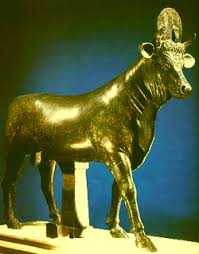

Jeroboam establishes Dan and especially Bethel as a replica of Jerusalem, with priests, sacrifices and feasts exactly parallel to God’s worship in Jerusalem. Jeroboam thus wilfully and purposefully establishes a competition worship, a parallel religion. Dan is quickly lost but Bethel becomes Israel’s national shrine, the center of its official religion, “the very center of Israel”, the “temple of the kingdom” (Amos 7:10,13). Jeroboam establishes Israel as an idolatrous nation from its very beginning.
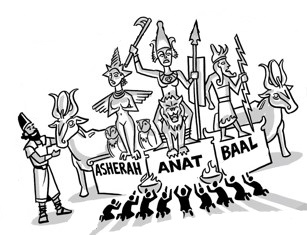
By Jeroboam II’s time (two hundred years later) the worship of other idols have been added to the national calf-cult. Amos 5:25 says “You shall take up Sakkuth your king, and Kaiwan your star-god, your images, which you made for yourselves”. Kaiwan and Sakkuth are names found in Assyrian inscriptions to refer to the planet-god Saturn. Amos 8:14 mentions “Ashima of Samaria”, “god of Dan” and “the way of Beer-sheba”, further idols and places of worship.
In summary we can say that Israel’s spiritual state during Amos’ time is very bad: the age-old mixed Yahweh-calf cult, many imported idolatries combined with social injustice. Worst of all, especially the elite of Israel has a sense that the current boom is a blessing of God, a proof that they are doing just fine in their outward religiosity. Empty religiosity and false security blind Israel to their real state. This is what Amos is up against. He goes into the very heart of Israel’s false beliefs, Bethel, and declares his searing message. What courage!
06 Interpretation Question: What other prophets spoke during Amos’ time?
- 2 King 14:25 mentions that Jonah (795-775 BC) is a contemporary of Amos. He is able to give Jeroboam II a positive word about God’s grace letting him restore Israel to former strength, which probably further convinced the upper class that all was well. Jonah’s other assignment it, of course, to preach to Nineveh.
- Hosea (755-722 BC) is a contemporary to Amos and addresses Israel just as Amos does. Shortly after Isaiah (735-700 BC) and Micah (730-700 BC) will start prophesying in Judah.
- Israel is completely and irreversibly destroyed in 722 BC by King Tiglath-Pileser and King Sargon II of Assyria. Amos and Hosea together are therefore God’s last call to Israel. Both prophets are equally serious and urgent in their message, Hosea with a heart-rending love story of a spurned God, Amos with a searing and biting critique of social injustice and hollow religiosity.
We have now understood enough about the historical situation of Israel when Amos addresses them. We will now look at the first two chapters of Amos and some main themes.